It was one of the boldest actions in the history of armored forces. On January 23, 1945, the Soviet armored reconnaissance group struck straight at the fortified Elbląg. And no one even noticed her.
The 31st Kirovgrad Armored Guards Brigade was just engaged in the fight to capture Iława when it was assigned a new assignment. The commander of the 29th Panzer Corps, General Małachow, ordered the brigade to leave the city immediately and attack immediately north, towards Elbląg. According to the order of the commander of the 2nd Belorussian Front, Marshal Rokossowski, the Elbląg, Pasłęk and Młynar regions were to be captured by January 24, 1945.
Direction to Elbląg
The commanding officer of the brigade, Lt. Col. Aleksandr Pokołow, was not delighted. Twenty-degree frosts and thick snow cover effectively hindered the movements of his units. Aviation was grounded.
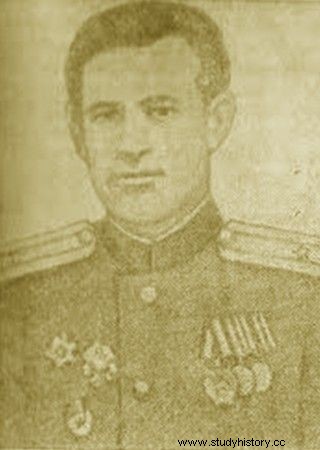
And here is Captain Genady L. Diachenko himself.
He was also concerned about the lack of information about the enemy, his numbers and the distribution of troops. He had to find out what his brigade might meet on the way.
Therefore, Lieutenant Colonel Pokołow decided that the brigade would be headed by a separate armored unit, which would pave the way and recognize the positions and strength of the Germans. His choice fell on the 3rd tank battalion under the command of Capt. Genadij Lvovich Diachenka.
The 3rd battalion was to move from the region of Iława towards Zalewo, and forwards to Elbląg. Of course, with such lean forces it was impossible to try to capture the city, so it was necessary to walk around it from the east. Diaczenka's tanks were to end their route in Rubno Wielki, north of Elbląg, on the Vistula Lagoon itself, and wait there for the rest of the brigade.
So the action was prepared in a truly cavalry style. Soviet tanks had to travel about 90-100 km in 24 hours, in unfamiliar terrain and in unfavorable weather. The views of the tankers for survival were paltry to say the least.
The armored squad starts
Diachenko's armored group set off on Tuesday, January 23, early in the morning. It was snowing heavily and it was bitterly cold. The 3rd battalion consisted of only 9 T-34/85 machines (out of 21 employees). At the head were three tanks of the platoon, 2nd Lt. Andrei Alejnikov, with the scouts of 2nd Lt. Bieriegowa.
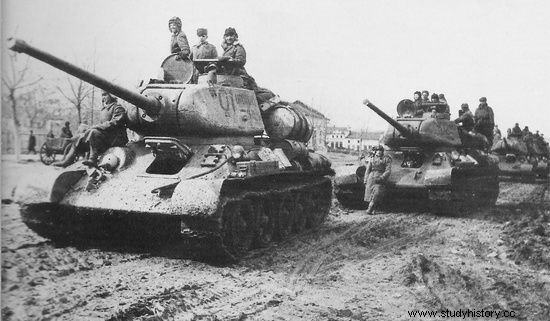
T-34/85 tanks. Only nine such armored cars were at Diachenko's disposal when he started his rally.
The remaining T-34 battalion carried a platoon of fusiliers on armor. It was not allowed to open fire as ordered. The use of the radio is only permitted in emergencies. The idea was to delay as much as possible the moment when the Germans found out about the Soviet tankers.
The tanks advanced smoothly. Sometimes they came across columns of German refugees. One of the tanks even collided with a wagon which he pushed into a ditch. Twice the Soviet tanks missed the enemy transport columns that simply ran out of their way. Most likely, the Soviets were taken for their own in a snowy blizzard.
In such conditions, the cars of the 3rd battalion reached Pasłęk, behind which Diaczenko ordered a stop. It was then realized that two T-34s were missing, probably lost in the narrow streets of a Prussian town. Though they might as well, knowing their legendary "reliability", have broken somewhere along the way. The decision now had to be made:what next? So far the tanks have encountered no resistance. According to the orders, Diachenko was to walk around Elbląg from the east with his tanks. Meanwhile, it turned out that such a path ... does not exist at all . The Soviet commander decided to take a risk and break through the city.
Festung Elbing
The Germans prepared Elbląg quite well for defense. The field fortifications have just been expanded, consisting of three lines of ditches, anti-tank and anti-personnel barriers, machine and anti-tank weapon positions. There was also a large army in Elbląg, about 40 different units. The supplies accumulated in the city were supposed to last for at least two months of the siege.
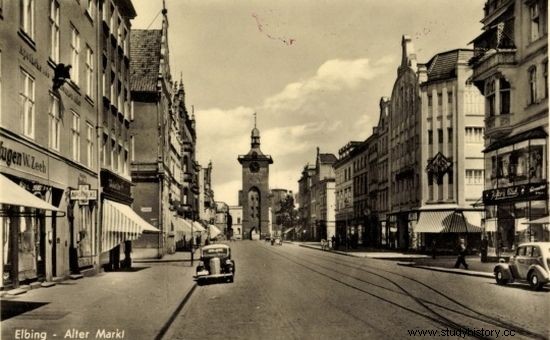
Elbląg (or rather then still Elbing) on a postcard from the interwar period. In January and February 1945, this beautiful city was severely damaged.
One fact spoke in favor of the Soviets. In fact, in Elbląg no one seriously thought about the arrival of the enemy's troops. Though crowds of refugees swarmed the streets, the city otherwise lived a normal life. There were shops, cafes, bars, a cinema, in other words, a real idyll in these difficult war times. Nobody expected the idyll to end any day.
Bolsheviks in the streets!
Soviet tanks reached Gronów Górny, about 7 km before Elbląg. There tankers joined the great column of refugees heading for the city. This way they bypassed the defense lines. And still no one recognized them.
The first obstacle they encountered was the enemy's transport column. Ram and keep going - Diachenko orders. The leading T-34, 2nd Lt. Alejnikowa opens fire with machine guns. There is a sound of crushed sheet metal. The other two tanks of his platoon are also not idle and the German cars are literally swept off the road. The battalion moves towards the center. From a small hill you can see the airport. This time the guns of the lead platoon speak. Numerous fires can be seen at the bombed airport.
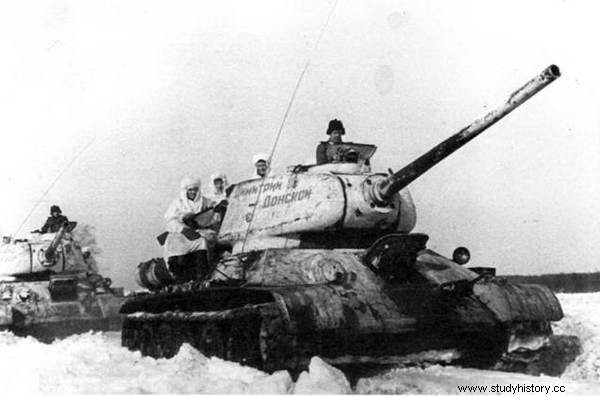
Soviet infantry clinging to the armor of T-34 tanks. Of course, this picture could not be missing during Diachenko's rally.
Then the tanks move towards the center. They enter the Dworcowy square, filled with refugees, right next to the train station. A ruthless massacre of civilians, including women and children, begins. Scouts and fusiliers also join the action. The Soviets then move on. They wander the streets of the city. Only now is Germany shaking off its lethargy. The battalion is under fire. There are no losses so far.
Fight in the Egyptian darkness
It is getting dark in the streets. At the behest of the municipal authorities, the lighthouses were turned off. Diachenko orders the tank headlights to be turned on. In their glow you can see cars towing anti-aircraft guns. Alenikov's platoon is ordered to eliminate them. Three Soviet tanks strike the battering ram again.
The second lieutenant's tank makes its way through this battlefield and enters a restaurant full of German soldiers. The ceiling collapses. The machine, while backing up, hits a tram that is just going in, overturns it. Alenikov, at this point, is left with only two tanks of his platoon. The remaining battalion cars are nowhere to be seen.
Meanwhile, Diachenko was having a hard time. His tank was hit by an anti-aircraft gun and caught fire. Fortunately, the crew evacuated in time. Diachenko switched to another machine and the column moved on.
Meanwhile, Alejnikov, far ahead, turns back at the command of the commander. He wants to join the rest of the battalion. His platoon reaches the place where the tram has overturned. There, the second lieutenant's T-34 unexpectedly receives a hit from an enemy gun.

The machine is slightly damaged, but the most important thing is that it remains operational. The driver-mechanic, Sergeant Kamenev, is injured. Hostile fire grows thicker. Alejnikov himself sits in the driver's seat and the platoon moves on. Tanks stop for a moment next to the burning T-34 of Cpt. Diachenki and then they head north. They manage to catch up with the rest of the battalion just outside the city, around 22.00.
Task completed
The armored group of Capt. Diachenka reached Rubno Wielki and took up defensive positions. There, the next morning, Soviet tankers managed to destroy the German railway depot and several barges on the Vistula Lagoon. The rest of the brigade reached them in the afternoon.
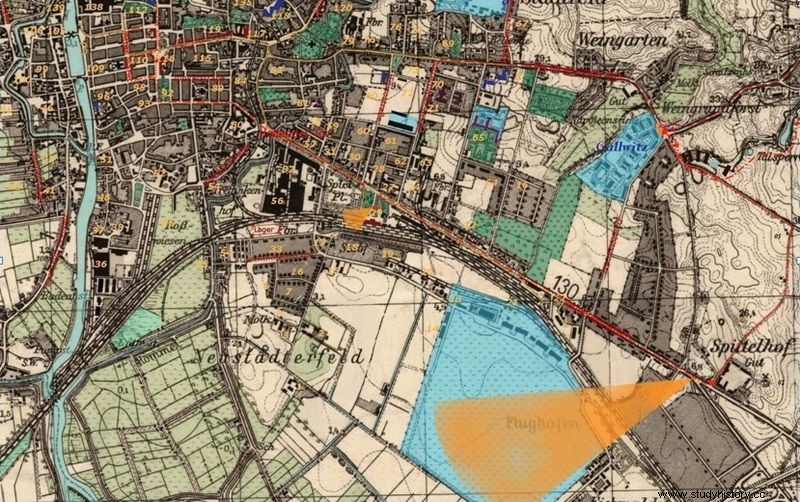
Map with marked route of Captain Diachenko's rally. The plan was originally published in the book by Tomasz Stężała, "Elbing 1945. Found memories" (IW Erica 2010).
Panic broke out in the city after the Soviet armored personnel raid. The leadership of the NSDAP, so far reluctant to do so, suddenly ordered the evacuation of the civilian population. And though the order was swiftly canceled, nothing could have prevented the ensuing chaos. In a short time the roads towards Gdańsk swarmed with refugees leaving the city for fear of the Red Army.
The Russians did not manage to take the city on the march, as planned. The alarmed Germans prepared themselves well for defense. Later that evening, they successfully repelled tanks of the 29th KPanc. General Małachow trying to break into Elbląg, following Diaczenko's footsteps. Eventually, the city fell on February 10, 1945 after bloody battles.
